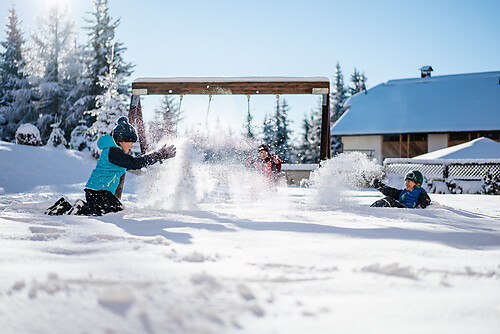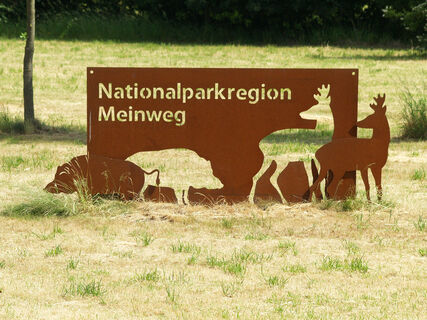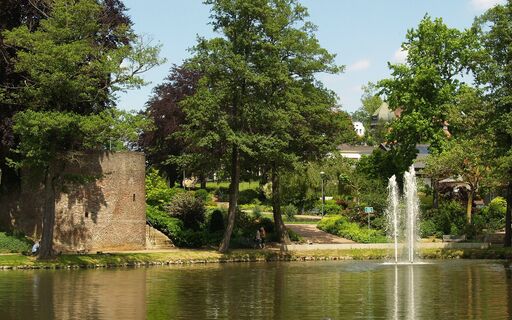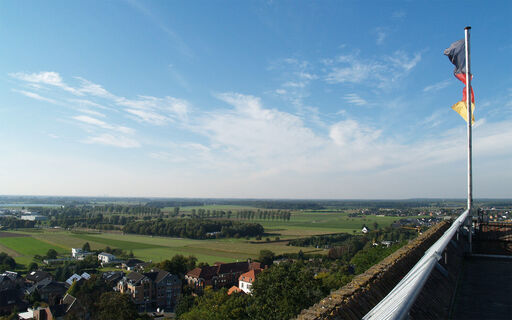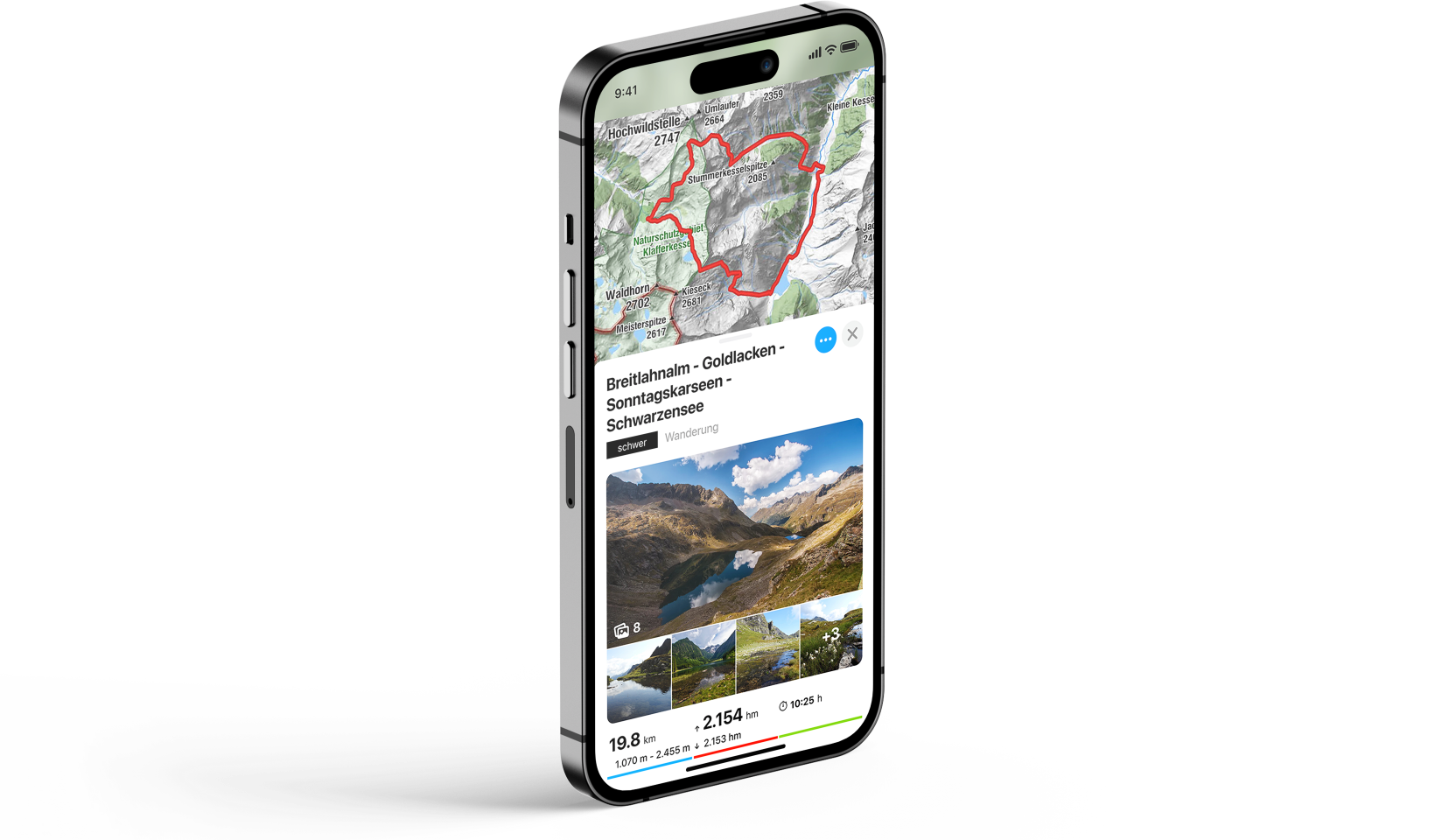Route tip 100 - 2nd Cycling Experience Day Lower Rhine 2025
From Wassenberg, you cycle through the MeinWeg National Park Region to Niederkrüchten and then along the Schwalmbruch to Brüggen. Almost the whole route to Wegberg follows the Schwalm to Merbeck. Via Tüschenbroich...
From Wassenberg, you cycle through the MeinWeg National Park Region to Niederkrüchten and then along the Schwalmbruch to Brüggen. Almost the whole route to Wegberg follows the Schwalm to Merbeck. Via Tüschenbroich and Wildenrath, you return to Wassenberg.

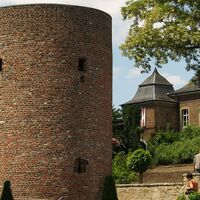




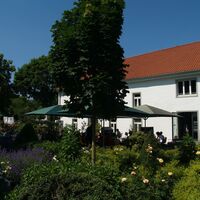
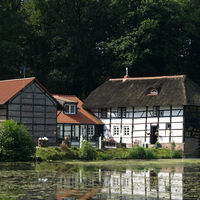
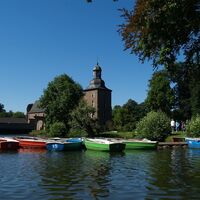
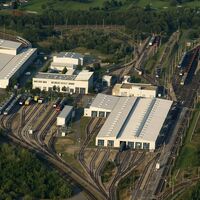
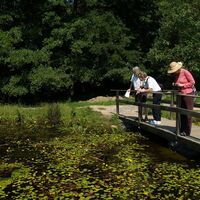
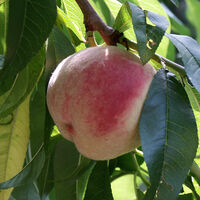

Wassenberg has been chosen as the starting point in this route description.
From the Wassenberg info point (nature park gate), cycle downhill to Parkstraße, turn right onto it and follow the signs to junction point (JP) 21 - which is near the Roßtor. Continue through the open Rur valley to JP 28 and up the Wassenberg Horst to JP 27. Via JP 75 you reach JP 76 and follow the signs further to Oberkrüchten (where JP 10 is located). A few hundred meters before JP 10, turn left and ride to JP 21. From JP 26 in Elmpt, follow Overhetfelder Straße for about 600 meters, then turn left onto Lehmkul path - here is the Elmpt info point (Lemkul 13, youth centre Treff 13) - then back to JP 26 and on to JP 39. Then it goes to JP 27 at the edge of Brüggen village. Then you cycle to JP 90 and further to JP 91 at Hariksee. In Niederkrüchten, there is JP 17, which takes you over JP 29 back into the Heinsberg region to JP 67. JP 68 is in Schwaam and JP 71 in Wegberg. A short distance in the direction of JP 72 and you reach the Wegberg info point (Wegberger Mühle, Rathausplatz 21, 41844 Wegberg). The JPs 72, 73, 74, and 29 guide you to the edge of the Wassenberg Horst. Cycling downhill, follow the signs to JP 21 and reach Pontorsonallee, which takes you straight to the Wassenberg info point, nature park gate.
Sights along the route:
On the way to JP 21, you pass the Wassenberg Gondelweiher and the Verlorenenturm (where in the Middle Ages people sentenced to death were held before execution – hence the name), as well as small alleys leading to Roßtorplatz with the medieval gate fortification and the Old Town Hall. Then follow the signs to JP 28. You cycle through the open Rur valley, where Rhine and Meuse rivers alternated hundreds of thousands of years ago, leaving behind sand and gravel now mined here. From the open field, you have a beautiful view of the wooded heights of the Wassenberg Horst with many small valleys directing rainwater to the Rur valley.
At JP 28 is Elsum Castle, a small water-surrounded complex. The castle consists of two parts: the core castle built at the beginning of the 16th century and the outer castle established in the early 17th century. The core castle stands on an irregularly rectangular, artificially created and walled island. It can be reached from the outer castle by a bridge. The manor house has three towers. Also on the island next to the manor house is the neo-Gothic castle chapel built in 1860 (the castle is still privately owned and not open to visitors).
Through Birgelen, you now ascend to JP 27 – a height difference of about 50 meters to overcome. On the way to JP 75, you cross the Schaagbachtal nature reserve. The entire town area of Wassenberg belongs to the Schwalm-Nette Nature Park due to its rich natural and plant diversity. Information can be obtained at the nature park gates in Wassenberg (Pontorsonplatz) and Brüggen (castle). Since 2024, Wassenberg holds the title "climatic health resort."
JP 76 is located in Dalheim-Rödgen and now you follow the signs towards Oberkrüchten – or make a short detour to the Motte „Alde Berg“ behind the ponds on Anton-Raky-Straße. It is a medieval motte-and-bailey castle located in the Helpenstein Brook Valley. The site consisted of a large mound and a large outer castle. Beeches now grow on the site. Little is known about the early history of the motte; it is suspected to have been built in the late 12th century.
Through the shaded forests of the MeinWeg National Park Region, you enter Viersen district heading to JP 10 in Oberkrüchten. A few hundred meters before reaching this junction, turn left to JP 21. Via JP 21, you cycle to JP 26. From JP 26 in Elmpt, follow Overhetfelder Straße about 600 meters and turn left onto Lehmkul path - here is the Elmpt info point, Lemkul 13, youth centre Treff 13. Then cycle back to JP 26 and continue to JP 39.
JP 27 is the next destination. Just before, you pass through Brüggen. The castle there houses a nature park gate and the “Man and Hunting” Museum, presenting fascinating traces of 300,000 years of human hunting existence: http://menschundjagd.de
At JP 90 lies the Borner Lake, which, like many other ponds and lakes on the route, is fed by the Schwalm or its tributaries. On the way to Hariksee, you pass the Mühlrather Mill to JP 91. At this Schwalm mill, first mentioned in 1447, two preserved mill wheels still turn.
JP 17 is located in Niederkrüchten, and along the way, you cycle through the Schwalmbruch fauna-flora habitat, past the somewhat off-route Lüttelforster Mill, to JP 29 in Lüttelforst. Crossing the Schwalm leads to JP 67 in the Heinsberg region.
Noteworthy are the thatched roofs of the houses in the small village of Schwaam, where JP 68 is located. Via the Molzmühle, whose undershot water wheel was powered by the Schwalm and Mühlenbach, you continue. Today, the buildings house gastronomy and a hotel.
On the way, you cross the L3 (Dülkener Straße) at a demand traffic light. Going downhill, after about 100 meters, you reach the Schrofmühle. It is one of formerly 20 water mills in Wegberg. With its first documented appearance in 1558, it has a history of over 450 years. As a museum, it vividly shows the development of mills along the Schwalm. http://www.schrofmuehle.de
Back on the route, you pass the Holtmühle with its large pond towards Wegberg. It presumably served as oil and grain mill from the 14th century. Since the mill pond, along with the grain mill pond in Tüschenbroich, is one of the largest water reservoirs for mills in the Wegberg urban area, it could be economically operated until 1954. The water wheel has a very large diameter of 6 meters.
JP 71 is located below the church St. Peter and Paul. At the intersection shortly before the junction, turn right (towards JP 72) and reach the Wegberg info point (Wegberger Mühle, Rathausplatz 21, 41844 Wegberg).
Riding towards JP 72, you cross the Grenzlandring, which runs around Wegberg and was used for major car and motorcycle races from 1948 to 1952. One of the most serious accidents in international motorsport history abruptly ended racing on the ring.
Along the Schwalm, you now pass several water mills – only some are still recognisable as such today – to JP 72 at Tüschenbroich Castle.
Since Carolingian times, there has been a castle here. Initially, there was the motte (an earthen mound castle fortified with palisades) in the middle of the pond, first documented in 1172. These buildings burned down during the Thirty Years' War. In 1624, Franz von Spiering bought war-damaged Tüschenbroich for 24,200 Reichstaler. He had the current water castle newly built on the "mainland," with the main building, a 35-meter-long brick building with a tower. Construction continued into the 18th century. It is privately owned and only visible from the outside.
At the lake's banks lie two mills, and you can take a boat ride or play mini golf.
Next is JP 73 at the end of Tüschenbroich, then through the former Royal Air Force airfield, where the testing centre for rail vehicles is now located, to JP 74. Here, a short detour to the Wildenrath Nature Conservation Station is worthwhile. Formerly a Frankish farm and later a knight’s estate, Haus Wildenrath belonged to the counts of Wassenberg in the 12th century. The current buildings were built in the 17th century and used as a farm until the 1960s. Today, the listed farm complex houses the Nature Conservation Station. Ecological research is conducted, and numerous nature education programs are offered. These include landscape conservation and the breeding of endangered domestic and farm animal breeds. https://www.naturschutzstationwildenrath.de/
From Haus Wildenrath, narrow paths lead through the Schaagbachtal nature reserve – notably the premium hiking trail “Birgeler Urwald”.
On the way to JP 29, on the right side is the old fruit variety garden, dedicated to preserving old fruit types. On the site of a former peach plantation between Wildenrath and Wassenberg along the B221, the Wildenrath Nature Conservation Station, supported by the Rhineland Landscape Association (LVR), has been developing the fruit variety garden since 2009.
Down into the Rur valley, you now head to Wassenberg towards JP 21. You pass the Wingertsmühle, which served as an oil mill since the 16th century and burned down at the beginning of the 19th century. Afterwards, it was repeatedly rebuilt and now stands – without wings – among tall trees.
Soon you reach Pontorsonallee and cycle uphill to the info point in Wassenberg, the nature park gate.
Take a leisurely walk through the medieval town centre or climb the keep from which you have a wide view over the Rur valley landscape.
Igen
To participate in the raffle of the Cycling Experience Day, you need a smartphone to scan QR codes. This involves questions that can only be solved and entered at the starting points. It is also possible to upload and post photos. Registration is voluntary; you can also join without it. The former central tombola has been replaced by an online raffle. There are three high-quality prizes to be won. Therefore, starter cards are no longer available.
Furthermore, you are well equipped for the route with weather-appropriate clothing, sufficient water, and some provisions.
Please observe cycling traffic rules and be considerate of others.
By bicycle
Whether you come from Germany or the Netherlands, the cycling network in the Heinsberg region is seamlessly connected via its junction points to all bike networks of the neighbouring regions, allowing you to enter from all directions without difficulty. Cross-regional cycling networks connecting you to the region include the RurUfer Cycle Path, the NiederRheinroute, and the Green Route. When arriving by car/train/bus and bike, you will find a convenient entry point into the route network from any station or tourist destination.
By car
The Heinsberg region is accessible via the federal motorways A 52 (north), A 46 (east), and A 44 (south), as well as the Dutch A 2 (west). The cities Aachen, Cologne, Düsseldorf, Duisburg, and Mönchengladbach, as well as Maastricht and Eindhoven in the Netherlands, are within 60 kilometres. Important federal roads run north-south (B 221 and B 57) and east-west (B 56 and B 56n, which bridges the gap between A 46 and Dutch A 2). Regional traffic is supported by a dense network of state, district, and municipal roads. Look out for tourist signage on site; it will reliably guide you to your destinations.
By plane
From the internationally significant airports Düsseldorf International and Cologne-Bonn, the Heinsberg region can be reached by car in approximately 45 and 60 minutes respectively. Airport Weeze on the northern Lower Rhine and the airports Eindhoven and Aachen-Maastricht on the Dutch side are also about an hour away by car.
By train
The Heinsberg region is connected to the German rail network via three railway lines. The Aachen – (Heinsberg) – Düsseldorf railway line enables travel via the stations Übach-Palenberg, Geilenkirchen, Lindern, Brachelen, Baal, and Erkelenz. From Lindern, it goes to Heinsberg (HS) via the stations HS-Randerath, HS-Horst, HS-Porselen, HS-Dremmen, HS-Oberbruch, HS-Kreishaus. The greater Wegberg area is accessible via the Dalheim – Rheydt/Mönchengladbach line (stations: Dalheim, Arsbeck, Wegberg). The Aachen – Eindhoven line also connects to the Dutch stations Roermond and Sittard. www.bahn.de
The route is accessible via Wegberg station.
By bus
The local bus network in the Heinsberg region is operated by WestVerkehr GmbH and is connected to the Aachen Transport Association (AVV). AVV tariffs apply. More information and timetable: www.avv.de
Additionally, the so-called MultiBus is available county-wide. It is an on-demand service by WestVerkehr GmbH. Passengers simply call about 60 minutes before planned departure and then receive information about when the MultiBus will pick them up at the nearest MultiBus stop (Tel.: +49 2431 886688). More info: www.west-verkehr.de
Train & bike
Generally, traveling by train with a bicycle is easily possible. Deutsche Bahn timetables indicate which trains have bike carriages. Since bike spaces are limited, groups should register with the railway in advance. www.bahn.de
Bus & bike
On weekdays from 7 pm, Saturdays from 3 pm, and all day on Sundays and holidays, bicycles are allowed on local buses in the Heinsberg region. A maximum of 2 bicycles per vehicle is permitted.
By bus and bike through the Heinsberg region – the “Heinsberg Region Bicycle Bus”
During the season, the “Heinsberg Region Bicycle Bus” takes excursionists with and without bikes to their respective tour starting points every Saturday and on Sundays and holidays and picks them up again afterwards. While you sit comfortably in a west-MultiBus, your bike is safely transported in the attached bike trailer. The buses have seating for 7 people. Up to 16 bikes can be transported in the attached bicycle trailer. By the way, if you arrive by train, the bicycle bus also picks you up directly at the stations in the Heinsberg region. The bicycle buses operate between 9:00 and 20:00 and stop at many points. They do not follow a fixed route or schedule. Instead, you can pre-order the bicycle bus at the desired time at the desired bus stop via the MultiBus central. To book a place for your preferred date, call the westBicycleBus via the MultiBus hotline 02431/886688 (at least one day before the tour). Whether cycling or hiking, with the bicycle bus you can conveniently reach the most beautiful routes in the Heinsberg region and enjoy a relaxed start or finish to your tour. A fare overview and special offers for groups are available at www.west-verkehr.de
The Selfkantbahn,
the only and last narrow-gauge steam train in North Rhine-Westphalia, is not only a popular excursion destination but remains a means of transportation: passengers and their bicycles are gladly carried along. It usually runs from Easter to the end of September on Sundays and holidays between the stations Gangelt-Schierwaldenrath and Geilenkirchen-Gillrath. www.selfkantbahn.de
Wassenberg: Parking lot at the nature park gate, Pontorsonallee 16, 41849 Wassenberg
Wegberg: Parking lot at the Wegberger Mühle (paid) or parking lot on Venloer Straße
WFG for the Heinsberg District mbH
Heinsberg Region
Tel.: +49 2452 131415 Fax: 131419
E-Mail: info@heinsberger-land.de
Internet: www.heinsberger-land.de
Take a walk through the old town of Wassenberg with its preserved medieval buildings, along the Gondelweiher pond or through the Judenbruch forest. The local gastronomy also offers many culinary delights.
Népszerű túrák a környéken
Ne maradjon le az ajánlatokról és az inspirációról a következő nyaralásához!
Az Ön e-mail címe hozzá lett adva a levelezőlistához.




